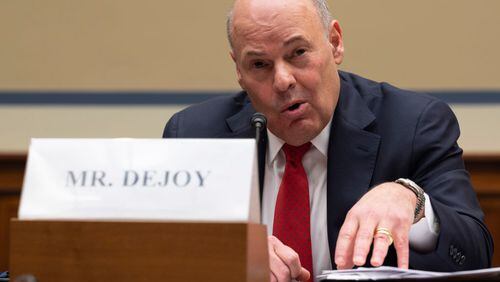The yearend spike in Central American children and families illegally crossing the southwest border – a thorny problem with big implications for Georgia and other states – may be part of a "new normal," the nation's border chief said during a stop in Atlanta Friday.
“We are watching it pretty carefully — we are concerned,” said U.S. Customs and Border Protection Commissioner R. Gil Kerlikowske, who was visiting with police in Buckhead about human trafficking. “Perhaps we are seeing a new normal with a lot of people wanting to come across that southern border into the United States.”
Fleeing punishing poverty and brutal gangs, tens of thousands of people from El Salvador, Guatemala and Honduras started surging across the border in 2014. Their numbers fell toward the end of that year and stayed lower in early 2015 before rising sharply again. Between October of 2015 and January of this year, apprehensions on the southwest border were more than double the number from the same period the year before. Most of those who were caught are from Central America. Some are from Mexico.
Since last fall, 717 of the apprehended children and teens have been transferred to the care of sponsors in Georgia, mostly in Cobb, DeKalb and Gwinnett counties. That brings the Peach State's total since 2013 to 3,792. Many have enrolled in public schools in North Georgia, sending educators scrambling to accommodate them.
A 2008 anti-human trafficking law — signed by President George W. Bush — prevents the government from immediately deporting them. Instead, the government is required to feed, shelter and provide medical care to them until they can be released to the care of sponsors, who are usually relatives. Meanwhile, the children undergo deportation proceedings in federal immigration courts in Georgia and other states where they can seek relief to stay in the U.S.
But many of them and their parents have been ordered deported. And that has triggered immigration raids in Georgia. In January, federal authorities arrested 121 adults and children in Georgia and elsewhere as part of a nationwide crackdown targeting Central Americans who were caught illegally crossing the border and ordered to leave the country. U.S. Homeland Security Secretary Jeh Johnson announced last month the crackdown would continue, despite objections from federal lawmakers and advocates.
The influx of these children has also reignited the contentious debate over immigration Georgia. It became a flash point in the 2014 gubernatorial race between Gov. Nathan Deal and then-state Sen. Jason Carter after Deal sent a scathing letter about the issue to President Barack Obama.
In an interview with The Atlanta Journal-Constitution Friday, Kerlikowske pointed out that apprehensions started falling in January. He added the government is in a better position to respond to the surges this year because it has opened several processing centers — converted warehouses — for the apprehended immigrants in McAllen, Texas. At those centers, authorities try to identify their smugglers and the routes they took to get into the U.S. The government, he said, has also sent officials into Mexico to observe and train immigration authorities there.
At the same time, Kerlikowske pushed back against notions that lax border security is the cause of the problem and that building a wall there would solve it. Those illegally crossing the border, he said, are coming here to escape violence, reunite with relatives, find work and send money to families back home. Many are giving themselves up to U.S. Border Patrol officials when they reach the other side, he said, hoping they will be allowed to stay here for humanitarian reasons.
“It isn’t like we have large numbers of people that we are chasing and trying to apprehend,” he said. “They have been told by the smuggler, ‘Look for the person in a green uniform because you will be protected.’”
Kerlikowske didn't mention Republican presidential frontrunner Donald Trump by name, but Trump has proposed building a wall along the southwest border at Mexico's expense. Kerlikowske pointed out there are a lot of obstacles there, including the Rio Grande and swaths of private property. Further, he said, the existing fencing along the border needs expensive upkeep. The government is also using horseback patrols, video cameras, motion detectors and unmanned aircraft to protect the border, Kerlikowske said.
“It’s an incredibly complex problem,” he said. “And whenever someone has a simplistic answer to a complex problem, you can pretty well bet it is wrong.”






